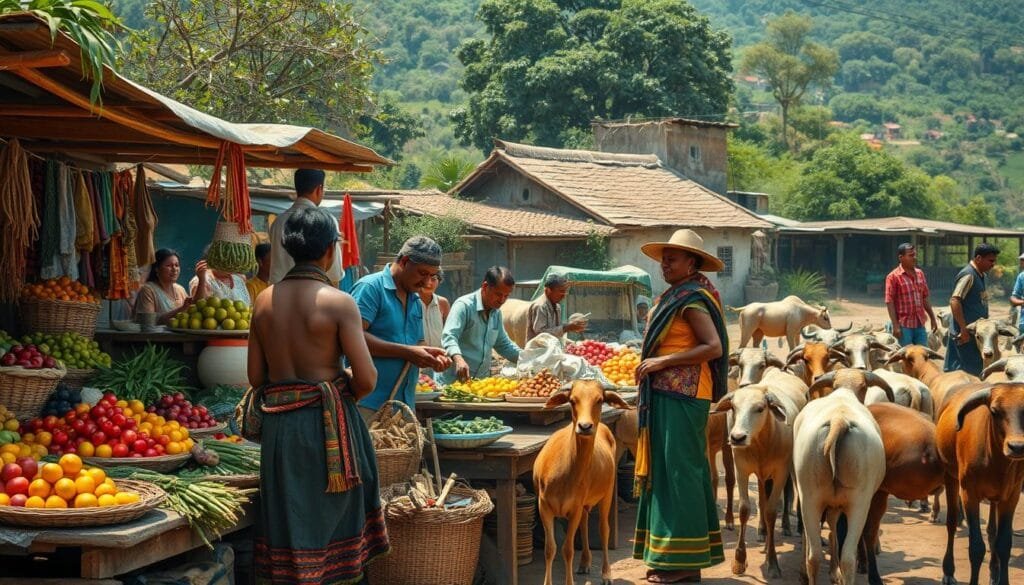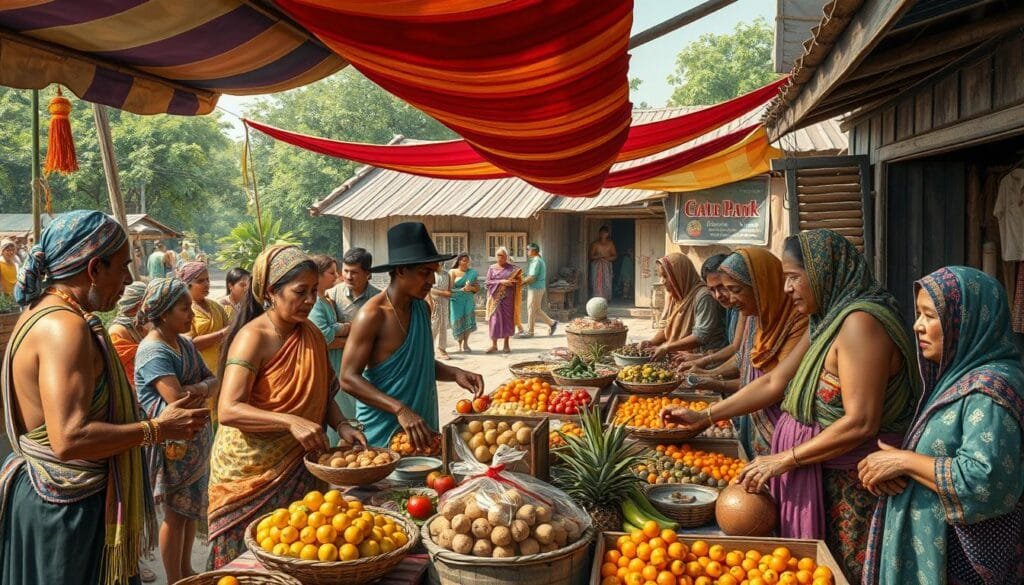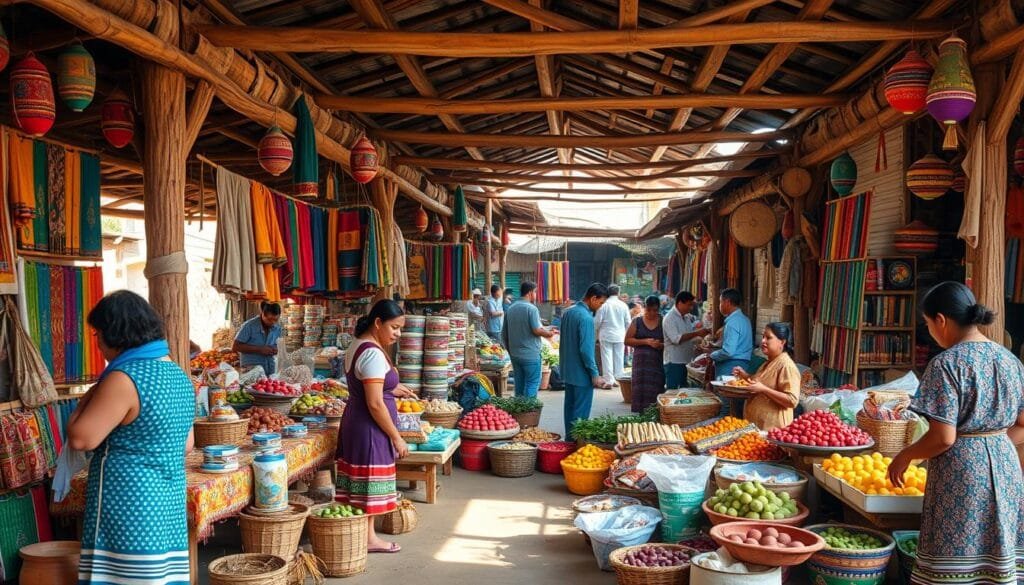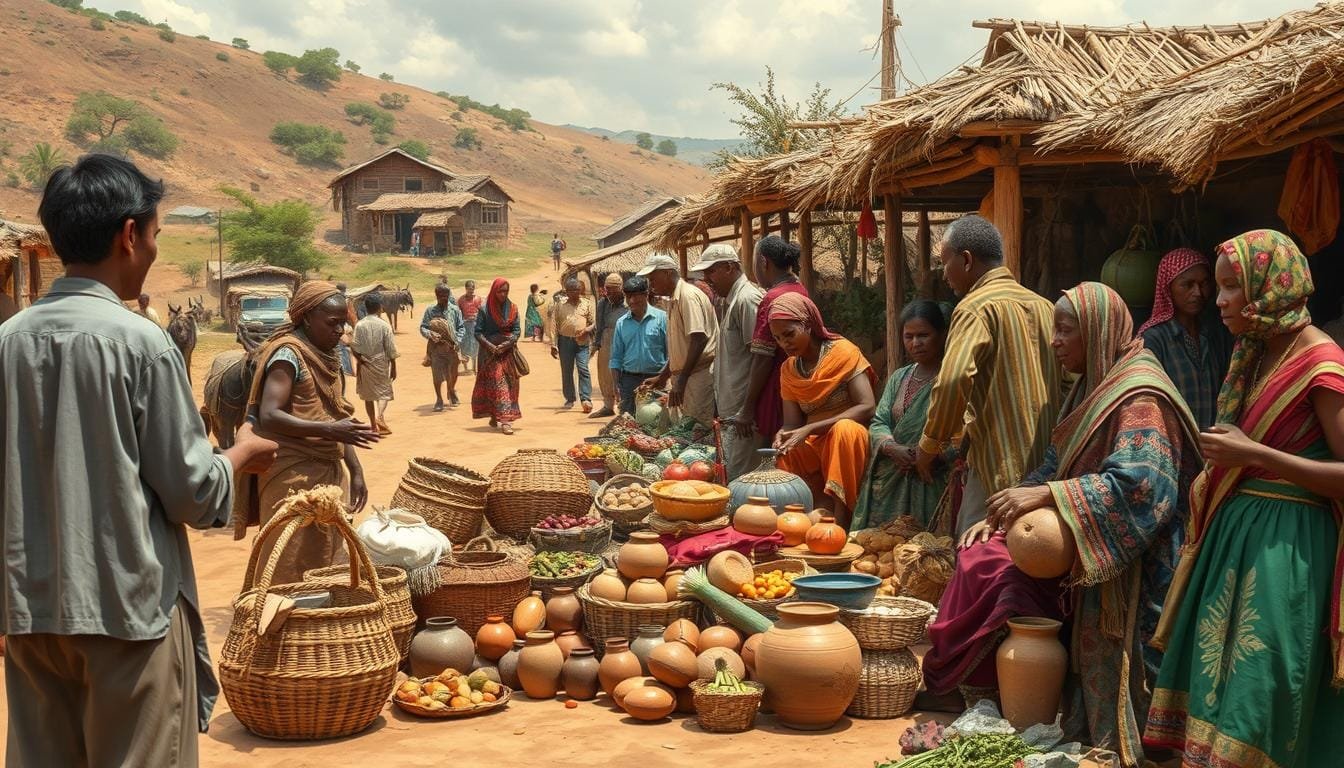The global market is full of various trading methods. Yet, trade practices in traditional economies are quite different. They show us how closely cultural customs are linked to economic activities. These economies mainly rely on farming. They also include hunting, fishing, and gathering. This way of life focuses on meeting the community’s needs rather than making extra goods.
In these societies, people trade by bartering instead of using money. This exchange system is based on old traditions. Before events like the Civil War and the Great Depression, the United States had a similar economy. Today, traditional economies are still around in places like Africa, Asia, and Latin America. They keep following their long-standing traditions.
Key Takeaways
- Traditional economies are built on community activities that focus on subsistence rather than trade surplus.
- Trade in these economies involves bartering, a direct trade of goods and services without money.
- The United States once showed traits of traditional economic systems.
- Even with today’s global market, traditional economies thrive in rural areas around the world.
- These systems mix cultural customs with economy, showcasing a lifestyle that has lasted for many generations.
Understanding Traditional Economic Systems
Traditional economies are deeply embedded in a society’s culture. These systems are often found in rural, untouched areas where people value their historic ways more than new market trends or government rules. They show how people living with what they need, making decisions based on old ways, keep their culture alive.
Definition and Core Principles
These economies run on what they can grow, hunt, and find. They don’t aim to make tons of money but to support each other and live off the land. This creates a strong community bond. Age, gender, and social status decide who does what, maintaining harmony.
Characteristics of Traditional Economies
Traditional economies depend on the land and simple tools. They aim to use resources wisely, avoiding harm to nature. Their main goal is to meet the community’s basic needs, often through swapping goods instead of using money.
Evolution from Tradition to Mixed Economies
These economies can grow into mixed ones when there’s extra from farming, starting trade and more defined jobs. This mix might bring in elements from capitalism, socialism, or communism. It’s a notable change from the old ways.
This look at traditional economies shows how deep-rooted customs guide economic actions. Even when these systems change or confront modern market challenges, their base in ancient practices helps us understand a life focused on sustainable living and community.
Let’s delve deeper into the data to understand how traditional economies function across different regions.
| Characteristic | Details | Impact |
|---|---|---|
| Economic Activities | Guided by tradition rather than market forces | Stable social order but limited economic growth |
| Bartering | Common practice, involves direct exchange of goods | Strengthens social bonds, reduces need for currency |
| Survival Focus | Production aimed at community needs | Sustainability and minimal environmental impact |
| Resource Management | Use of sustainable methods and simple tools | Preservation of cultural practices and knowledge |
How Traditional Economies Function
Traditional economies stand out in the world, showing us the value of sustainability and unity. They’re based on subsistence activities like agriculture, hunting, and fishing. These tasks are vital for the day-to-day living and future of the communities.
Role of Farming, Hunting, and Fishing
Farming, hunting, and fishing are key to traditional economies. They’re crucial for survival and connecting with nature. This lifestyle promotes sustainability, something often missed in modern economies. Skills for these activities are handed down generations, ensuring the community’s knowledge and strength continue.
Barter System vs. Currency in Trade
Unlike modern economies that use money, traditional economies use barter trade. This method trades goods and services directly, based on what people need. For instance, fishers can trade their catch for a farmer’s crops. This ensures everyone has what they need.
Family and Community in Economic Decisions
In traditional economies, families and communities decide together. They decide what and how much to produce, and how to do it. This method strengthens ties and ensures fair resource distribution. Everyone’s voice is heard, focusing on the common good.
This structure makes these economies steady, even when facing challenges like bad weather or pressure from larger economies.
| Economic Model | Core Activity | Trade System | Decision Making | Sustainability Focus |
|---|---|---|---|---|
| Traditional Economy | Subsistence: Farming, Hunting, Fishing | Barter | Community/Family-based | High |
| Market Economy | Production for Profit | Currency-based | Individual/Corporate | Variable |
| Mixed Economy | Combination of Subsistence and Profit | Both Barter and Currency | Mix of Community and Individual | Moderate |
| Command Economy | State-controlled Production | State-regulated Distribution | Centralized | Low |

Trading Practices Within Traditional Economies
In places with traditional economies, trade is shaped by community and the need to survive. These practices are tied to the culture and well-being of the communities. They help ensure the community can keep going strong.
The Importance of Bartering
Trade dynamics in traditional economies focus on bartering. This means trading goods without money, based on trust and cooperation. In places with few resources, bartering distributes goods and services. It also strengthens community ties and balances resources.
In regions like Papua New Guinea, living off the land with others is key. People there deeply understand and follow their unique trading norms.
Exchanges without Monetary Systems
Traditional economies work well without modern money systems. They value goods based on what people need, leading to practical use of resources. This matches the subsistence economy idea, aiming to meet current needs without waste.
For example, Arctic communities like the Inuit trade necessary items. They trade fish and seals, essential for their survival, through bartering.

These traditional economies build fairness and respect through non-money trades. These trades are more than just deals. They boost community unity and shared values, key for thriving long-term.
Overall, trade in traditional economies gives us lessons on cultural sharing, sustainability, and living together. These practices are key for both social and economic success.
Do Traditional Economic Systems Trade with Their Citizens
In traditional economic systems, community trade is key. It’s not just about economy; it’s also about keeping cultural identity. It sustains community bonds too. These systems value community welfare more than personal gain. Everyone has specific economic roles. Roles depend on family, age, and social standing. This ensures fair distribution of work and resources.
Traditional markets are different from modern ones. They follow old principles. Goods are exchanged through bartering. This matches supply with demand inside the community. Bartering strengthens social ties. It lets everyone get what they need without modern money.
| Economic Systems | Primary Activity | Community Engagement |
|---|---|---|
| Traditional | Bartering hand-crafted and agricultural products | High – Involves all family members |
| Command | Government-assigned production | Low – Limited public involvement |
| Market | Production driven by market demand | Medium – Individuals act independently |
| Mixed | Combination of market dynamics and government policies | Variable – Community-oriented in some scopes |
These markets also protect cultural identity. Every trade, every interaction is full of cultural meaning. It connects with the social fabric of the community. Traditional markets help keep local economies stable. They keep cultural uniqueness alive against globalization.
Traditional economic activities are woven into the community. This strengthens community resilience. This is especially true in remote areas of Asia, Africa, and South America. These places show how traditional economies keep their culture and economic independence. They do this despite global pressures and changes.

The Impact of Modern Markets on Traditional Economies
Modern markets have brought new ways of doing things to old economies. This change has had good and bad effects. It has caused major shifts in how people use resources and live their lives.
Modern markets make old economies join the world market. This change can bring more money and new ideas. However, it also puts pressure on local ways of life, which can be hard to balance.
In places with old economies, the use of natural resources has gone up a lot. New methods from modern markets can harm the environment. They can use up resources too fast, hurting the balance that was there before.
- Economic integration opens doors to global markets, which can make local products more profitable.
- Modern market influence can change traditional roles in society, showing how cultures evolve over time.
- Natural resource consumption increases as old economies start to use new farming and factory techniques.
When old and new economies meet, they often create a mixed system. This system can bring benefits but also problems. It can make economies stronger, but also hurt local cultures and use too many resources.
In the end, finding a way to combine the best of old and new is key. We must keep the good of old practices while adding new improvements. Doing this can help these economies grow in a good way.
Pros and Cons of Traditional Economic Systems
Traditional economic systems offer a rich mix of benefits and drawbacks. They are key in modern times. They hold cultural values at their core.
Advantages: Sustainability and Social Cohesion
One key benefit is their push for environmental sustainability. They use eco-friendly practices due to their reliance on nature. This includes farming and hunting, which help biodiversity.
These economies also stress societal roles and community bonds. Their social backbone is built on strong relationships and support. Everyone plays a role in shared economic activities, tying them to culture and community health.
Disadvantages: Vulnerability to External Shocks and Limited Growth
Yet, traditional economies have economic limitations. They may struggle to grow and adapt to global changes. Their size and tech limits make them prone to external economic pressures, such as market changes.
They’re also at risk from environmental shifts. Reliance on stable weather and ecosystems means they’re hit hard by climate change. This threatens their economic stability.
Below is a comparative table showing differences between traditional economic systems and others:
| Economic System | Key Characteristic | Typical Location | Advantages | Disadvantages |
|---|---|---|---|---|
| Traditional | Community-based, non-competitive bartering | Rural areas, developing countries | Environmental sustainability, strong communities | Susceptible to environmental changes, limited growth |
| Command | Government-controlled critical industries | USSR, North Korea, China | Low inequality, extensive job provision | Lack of competition, innovation deficits |
| Market | Encourages competition and innovation | Hong Kong, United States | Innovative, efficient resource use | Can lead to significant social inequalities |
| Mixed | Combination of government and private enterprise | India, France | Redistribution benefits through taxation | Complex regulations, potential for inefficiencies |
Examples of Traditional Economies Today
Today, we find traditional societies fascinating for their ability to survive and adapt. These communities highlight the power of keeping indigenous cultures and economic ways alive.
African, Latin American, and Arctic Communities
In places like rural Africa, certain parts of Latin America, and the Arctic, indigenous communities flourish with traditional economies. In Haiti, for instance, about 70% of the population lives in rural areas. They rely on farming to make a living. The Arctic Inuit, about 80% of them, depend on hunting, fishing, or trapping. This shows a strong bond to their traditional lifestyles, even in the toughest environments.
These societies weave their economic life with their culture, passing on practices from one generation to the next. It creates a fusion of economic change and maintaining culture. This way, modern needs are met with age-old wisdom.
Transition of Traditional Economies in Modern Times
Moving towards mixed economies is a big step for indigenous groups all over the globe. Places like Yemen and remote African villages still use bartering but are slowly embracing cash economies. Trading beyond local communities leads to this change. It’s a crucial move to keep their cultural identity while joining the global economy.
Arctic and Latin American communities adapt by migrating seasonally and using natural resources wisely. They show how to face economic challenges by blending traditional and modern ways. This helps them keep their culture alive while participating in wider economic activities.
It’s important to support these economic changes to ensure the survival of indigenous groups. Helping them thrive in today’s world without losing their unique cultures and economies is key.
Conclusion
In our journey through cultural economic systems, we’ve explored how traditional economies keep society’s legacies alive. They show us the value of self-sufficiency and interdependence. These systems often depend on subsistence agriculture. This means they focus on growing food and raising animals to support the community, not for selling in markets.
Bartering, trading goods without using money, remains crucial in these economies. This practice, along with the minimal use of technology and deep respect for traditions, shows their commitment to community and culture. Even though they’re wary of new technologies, traditional economies have strong social bonds and low unemployment.
But, facing the world’s economic diversity brings challenges for traditional economies. Their struggles include limited innovation, fixed social roles, and restricted freedoms. Yet, their commitment to sustainability and preserving culture is clear. As globalization speeds up, traditional economies remind us to balance progress with caring for our environment and communities. In times of uncertainty, learning from the past may guide us to a sustainable future.
FAQ
What are the common trade practices in traditional economies?
In traditional economies, trading often happens through bartering. Goods and services are swapped directly. This does not involve money but is rooted in cultural traditions. It focuses on meeting the community’s immediate needs.
How do cultural customs influence economic decisions in traditional economies?
Cultural customs are at the heart of decision-making in traditional economies. These decisions follow age-old traditions and are aimed at subsistence living. They ensure actions are good for the whole community.
What is the role of farming, hunting, and fishing in traditional economies?
Farming, hunting, and fishing are key for survival in traditional economies. They provide the basics: food and materials. This reduces the need for outside resources.
How does the barter system work in traditional economies?
The barter system lets communities trade goods and services without money. It’s based on mutual agreements. Everyone understands what each side needs and offers.
What roles do family and community play in the economic decisions of traditional economies?
Family and community are crucial in traditional economy decisions. Choices are made together, considering everyone’s role. The community’s well-being comes before personal gains.
Why is bartering important in traditional economies?
Bartering is vital in traditional economies. It allows trading without the need for money. It strengthens community ties and ensures everyone can sustain themselves.
Do traditional economic systems engage in trade with their citizens, and how?
Yes, traditional economic systems trade with their citizens. They exchange necessary goods and services. This supports the community’s culture and respects economic traditions.
How do modern markets impact traditional economies?
Modern markets bring currency and market-based trade to traditional economies. This can change how resources are used. It sometimes integrates economies or exposes them to new risks.
What are the benefits of traditional economic systems?
Traditional economies have low-impact practices, making them environmentally sustainable. They also have strong community bonds. Mutual support is key.
What challenges do traditional economic systems face?
These economies struggle with external shocks like natural disasters. Their growth is limited by relying on finite resources and resisting modern economic methods.
Can you give examples of traditional economies that exist today?
Today, traditional economies include the Sami in Scandinavia and some Alaskan Inuit communities. Also, rural areas in Africa, Latin America, and Asia still rely on farming, hunting, and fishing.
How do traditional economies adapt to modern times?
Traditional economies become mixed economies to survive modern times. They mix elements of capitalism or socialism. This helps them develop despite economic and environmental pressures.
